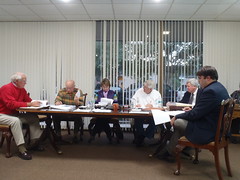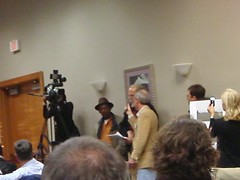From: “Michael G. Noll”Continue reading
To: Brad Lofton <blofton@industrialauthority.com>, “John S. Quarterman, Allan Ricketts, <aricketts@industrialauthority.com>
CC: “Susan R. Wehling”, “Mary B. Gooding”, Roy Copeland, Kay Harris
Subject: RE: Wiregrass Power, LLC
Date: Fri, 24 Dec 2010 13:46:25 +0000Hello Mr. Lofton.
I can certainly admire your determination to sell our community your biomass project as “green” or “safe”. However, as WACE already pointed out, there is a difference between fiction and fact (see my guest column in the VDT on December 12, 2010).
In the last couple months, WACE has provided the Industrial Authority and the community with a plethora of scientific literature and statements made by medical organizations that unequivocally state that biomass is neither “green” nor “safe”. At the same time, neither you nor Mr. Ricketts have been able to provide up-to-date scientific proof to us to challenge the position that biomass is, in fact, dirtier than coal and bears significant health risks.
Anyone who cares enough for the community he or she lives in, must understand the responsibility to provide such proof. I have difficulties to imagine that you or Mr. Ricketts do not share such a sentiment, despite the disagreements we might have. Let’s cut to the chase in regard to your panel of experts:
Category Archives: Renewable Energy
Brad Lofton: “Please have anyone interested e-mail us directly.”
To: John S. Quarterman, Allan Ricketts <aricketts@industrialauthority.com>,Continue reading
From: Brad Lofton <blofton@industrialauthority.com>
Cc: John S. Quarterman, Michael Noll, Susan Wehling, Mary B. Gooding, Roy Copeland, Kay Harris
Subject: Re: Wiregrass Power, LLC
Date: Thu, 23 Dec 2010 14:49:56 -0500John-
We enjoyed having you Tuesday night, and we were especially glad to have you attend on the night we planned to review the expert panel’s testimony regarding the positive environmental, health and economic impacts of our project. We appreciate you agreeing today to provide all of that data (or at least links) on your blog plus the recent flurry of pro-biomass press releases. As you know, December has been very active with EPA and USDA releases promoting biomass plus GA Tech and Duke researchers announcing that renewable energy (including biomass) will save Southeastern U.S. ratepayers $23 billion a year by 2030. That’s great news for residential and industrial consumers alike. The unanimous permission granted for the Gainesville, FL biomass facility was good news, and we were amazed at the large amount of support they received-from the FL State Department of Health, to the guardians of the Suwannee River basin, the U.S. Corps of Engineers, and numerous government and environmental groups in between.
Regarding access to our panel info, we have already e-mailed our panelists’ presentations to members of the public, and we would be more than happy to continue doing that. Please have anyone interested e-mail us directly.
Harrisburg, PA loses solvency and trust over incinerator
 Michael Cooper wrote in the New York Times on 20 May 2010 about
An Incinerator Becomes Harrisburg’s Money Pit:
Michael Cooper wrote in the New York Times on 20 May 2010 about
An Incinerator Becomes Harrisburg’s Money Pit:
HARRISBURG, Pa. — Officials here decided seven years ago to borrow $125 million to rebuild and expand the city’s enormous trash incinerator, which the federal government had shut down because of toxic air pollution.The Patriot-News Editorial Board wrote on 12 April 2010 about Harrisburg incinerator fiasco deserves an investigation to understand how it happened:But the incinerator burned through the money faster than the trash, leaving Harrisburg residents feeling like they were living through a sequel to the 1986 movie “The Money Pit.”
There were contractor troubles, delays, cost overruns and squabbles. The city borrowed tens of millions more, shoveling good money after bad into the job.
Over nearly a decade, officials at the Harrisburg Authority and City Hall made a series of decisions that sought to get the trash incinerator working and profitable, but which instead brought Pennsylvania’s capital to the brink of bankruptcy.The 2003 deal that took on $125 million in debt to repair the incinerator neglected to include a performance bond.
Something else sounds familiar about this situation:Inexperienced firms were hired. Fees were paid for work poorly done. Loans were taken on disastrous terms.
Officials were aided, or rather misled, by the advice of numerous attorneys, bankers and engineers apparently far more interested in collecting handsome fees than they were in protecting the interests of taxpayers.
As a result, there is a deep distrust of the fundamental institutions that created this fiasco.
While some of the seats have changed, many of the same people in government today had their fingerprints on these decisions.It’s the same old boy network locally as approved Sterling Chemical, and the chair of the county commission at that time is now on the Industrial Authority. And the VLCIA has taken on what is reputed to be a $15 million bond issue.
How big is Harrisburg? 50,000 people, same as Valdosta. What is Harrisburg considering? Bankruptcy. Who profited anyway? Local developers.
What’s the moral?
All of the guarantees proved worthless.What say we have the investigation now, before the fail-safes fail?All of the fail-safes failed.
-jsq
Seth Gunning LTE in the VDT
Continue readingRecently on Thursday December 16th, State Judge Ronit Walker denied air quality permits for a proposed coal plant in Sandersville, Georgia. Judge Walker cited the Georgia Environmental Protection Divisions failure to properly review permits, and their lack of enforcement of basic Clean Air Act standards for several hazardous emissions.
Flashback to April 27th in Valdosta Georgia when Environmental Protection Division Air Branch Manager Eric Cornwell openly admitted to having NOT READ the air permit application for Wiregrass Biomass LLC’s proposal to build a hotly contested 40mw power plant&emdash; during a Valdosta EPD hearing meant to evaluate those permits.
Today, the Valdosta Industrial Authority is hazardously entrenched
jsq to Col. Ricketts about VLCIA
From: John S. QuartermanContinue reading
To: “Allan Ricketts” <aricketts@industrialauthority.com>
cc: “‘John S. Quarterman'”, “‘Michael Noll'”, “‘Susan Wehling'”, “‘Brad Lofton'” <blofton@industrialauthority.com>, “Mary B. Gooding”, Roy Copeland, Kay Harris
Subject: Re: Wiregrass Power, LLCCol. Ricketts,
It’s good to hear from you.
I wondered during your re-presentation of slides you’d already said the entire VLCIA board had seen at the recent VLCIA biomass event, whether you would provide copies to interested parties, such as those sitting in the room, but you did not at the time.
Considering the increasing amount of public interest in this topic, as evidenced by the attendance and questions at the VLCIA Rainwater Conference Center event, and by recent newspaper activity, probably the public would like to see those press releases directly from the VLCIA’s web site. However, LAKE is always happy to link to relevant material, so if you will please send me the URLs of those press releases as you found them on the web, LAKE will be happy to link to them.
Similarly, if Dr. Teaf’s information is as good as you indicated,
Col. Ricketts on Wiregrass Power, LLC
From: “Allan Ricketts” <aricketts@industrialauthority.com>Continue reading
To: “‘John S. Quarterman'”
Cc: “‘Michael Noll'”, “‘Susan Wehling'”, “‘Brad Lofton'” <blofton@industrialauthority.com>
Subject: Wiregrass Power, LLC
Date: Wed, 22 Dec 2010 12:48:28 -0500
Hello John,

Norman Bennett, Gary Minchew,
Mary Gooding, Jerry Jennett (Chair),
J. Stephen Gupton (Attorney),
Brad Lofton (Executive Director)It was good to see you at the Valdosta-Lowndes County Industrial Authority Board Meeting on Tuesday evening. I encourage you to attend more often.
I’ve attached copies of several recent press releases that we discussed during the meeting. I look forward to seeing these posted on your information exchange for folks to read.
Please let me know if you would like a copy of Dr. Christopher Teaf’s .ppt
What’s the Industrial Authority’s Plan?
 What is the Industrial Authority’s plan to bring in real clean jobs?
What is the Industrial Authority’s plan to bring in real clean jobs?
MAGE SOLAR is hiring for the first of 350 jobs in its photovoltaic (PV) solar manufacturing plant in Dublin, Georgia, with half the population of Valdosta, in Laurens County, with half the population of Lowndes County. They’ve parlayed their position between the Atlanta airport and the Savannah seaport for many new clean jobs.
Suniva of Norcross’s second PV plant with its 500 jobs went to Michigan. Saginaw Valley calls itself Solar Valley and collaborates with governments, academia, and industry, winning thousands of clean jobs in wind and solar manufacturing and generating plants.
VLCIA biomass event Q&A
 Here are videos that illustrate the VDT’s point today in
What We Think:
Here are videos that illustrate the VDT’s point today in
What We Think:
While officials continue to downplay local citizen anger about current projects, citizens are organizing in a variety of ways to affect change the next election cycle. When Sterling Chemical came to Lowndes County in the 1990s, citizens were told the project was a “done deal,” and so it was. Sterling is still here, but those in office at the time aren’t, and the director of the Industrial Authority at the time is no longer here either.Maybe the VDT is referring to this kind of response from the VLCIA panel on 6 Dec 2010:As has been shown worldwide, citizens are tired of being told what’s best for them, having no say so in how their tax dollars are spent, and having their concerns ignored.
Until officials understand that it is coming from all directions and not just led by a few malcontents, the swell will continue to grow. And those who continue to ignore the anger and frustration do so at their own peril.
“these things do prop up the local economy, period, end of discussion.”A previous questioner who had a job in Vietnam notes he was lied to about Agent Orange and asks “can you assure me that I won’t be affected by this?” Continue reading
Where’s the wood to come from and who will buy the electricity?
 Here’s video of what I asked at the recent VLCIA biomass event
(6 Dec 2010) and the answers from the panel.
Here’s video of what I asked at the recent VLCIA biomass event
(6 Dec 2010) and the answers from the panel.
So there’s actually not any new study of wood sourcing (Brad Lofton told me after the meeting that the study had been “completed” after we met in June), and the study that exists is not publicly available. Someone from Sterling promised me after the meeting to redact the private parts of the wood sourcing study and provide the rest for public distribution. We’ll see.
Regarding my question about who will buy the electricity and whether we’ll end up like Plant Scherer, selling electricity to Florida while keeping the pollution here, the answer was: Continue reading
Real High Speed Rail: in China
 Here in the U.S., we’re still thinking about maybe doing some high
speed rail lines.
None in Georgia.
And even the slow-speed passenger proposed rail network bypasses Valdosta
and Lowndes County.
Here in the U.S., we’re still thinking about maybe doing some high
speed rail lines.
None in Georgia.
And even the slow-speed passenger proposed rail network bypasses Valdosta
and Lowndes County.
Meanwhile, in China:

(Click on the detail map for the full map from johomaps 2010.)